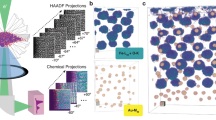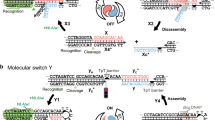Abstract
Magnetic resonance spectroscopy of single biomolecules under near-physiological conditions could substantially advance understanding of their biological function, but this approach remains very challenging. Here we used nitrogen-vacancy centers in diamonds to detect electron spin resonance spectra of individual, tethered DNA duplexes labeled with a nitroxide spin label in aqueous buffer solutions at ambient temperatures. This work paves the way for magnetic resonance studies on single biomolecules and their intermolecular interactions in native-like environments.
This is a preview of subscription content, access via your institution
Access options
Access Nature and 54 other Nature Portfolio journals
Get Nature+, our best-value online-access subscription
$29.99 / 30 days
cancel any time
Subscribe to this journal
Receive 12 print issues and online access
$259.00 per year
only $21.58 per issue
Buy this article
- Purchase on Springer Link
- Instant access to full article PDF
Prices may be subject to local taxes which are calculated during checkout


Similar content being viewed by others
Change history
14 August 2018
In the version of this paper originally published online, the ORCID ID for Peter Z. Qin was incorrectly assigned to Zhuoyang Qin. In addition, the ORCID for Fazhan Shi was omitted. These errors have been corrected in the print, PDF, and HTML versions of the paper.
References
Wrachtrup, J. & Finkler, A. J. Magn. Reson. 269, 225–236 (2016).
Balasubramanian, G. et al. Nature 455, 648–651 (2008).
Maze, J. R. et al. Nature 455, 644–647 (2008).
Degen, C. L., Reinhard, F. & Cappellaro, P. Rev. Mod. Phys. 89, 035002 (2017).
Shi, F. et al. Science 347, 1135–1138 (2015).
Shi, F. et al. Phys. Rev. B 87, 195414 (2013).
Grinolds, M. S. et al. Nat. Phys. 9, 215–219 (2013).
Grinolds, M. S. et al. Nat. Nanotechnol. 9, 279–284 (2014).
Grotz, B. et al. New J. Phys. 13, 055004 (2011).
Sushkov, A. O. et al. Nano Lett. 14, 6443–6448 (2014).
Schlipf, L. et al. Sci. Adv. 3, e1701116 (2017).
Lovchinsky, I. et al. Science 351, 836–841 (2016).
Tangprasertchai, N. S. et al. Methods Enzymol. 564, 427–453 (2015).
Kurad, D., Jeschke, G. & Marsh, D. Biophys. J. 85, 1025–1033 (2003).
Akiel, R. D. et al. J. Phys. Chem. B 120, 4003–4008 (2016).
Zhuang, X. et al. Science 288, 2048–2051 (2000).
Rugar, D., Budakian, R., Mamin, H. J. & Chui, B. W. Nature 430, 329–332 (2004).
Pezzagna, S. et al. New J. Phys. 12, 065017 (2010).
Hausmann, B. J. M. et al. New J. Phys. 13, 045004 (2011).
Qin, P. Z. et al. Nat. Protoc. 2, 2354–2365 (2007).
Zhang, X., Cekan, P., Sigurdsson, S. T. & Qin, P. Z. Methods Enzymol. 469, 303–328 (2009).
Acknowledgements
This work was supported in part by the National Key R&D Program of China (grant 2016YFA0502400 to F.S.; grant 2018YFA0306600 to J.D.), the National Natural Science Foundation of China (grants 81788104, 11227901, and 11761131011 to J.D.; grants 31470835, 91636217, and 11722544 to F.S.; grant 21328101 to P.Z.Q.), CAS (grants XDB01030400 and QYZDY-SSW-SLH004 to J.D.; grant YIPA2015370 to F.S.), the CEBioM (F.S.), the Fundamental Research Funds for the Central Universities (grant WK2340000064 to F.S.; grant WK2030040088 to P.W.), the China Postdoctoral Science Foundation (grant BX20180294 to F.K.; grants BX201700230 and 2017M622001 to Q.Z.) and the US National Science Foundation (grants CHE-1213673, MCB-1716744, and MCB-1818107 to P.Z.Q.).
Author information
Authors and Affiliations
Contributions
J.D. supervised the entire project. J.D., F.S., and P.Z.Q. designed the experiments. F.K., P.Z., and F.S. performed the experiments. X.Z. and P.Z.Q. prepared the DNA duplex. X.Z., M.C., X.R., J.S., and P.Z.Q. measured the ensemble data. P.Z., M.C., Z.W., S.C., and P.Z.Q. carried out the chemical bonding process. M.W., X.Y., and P.W. fabricated the pillar and conducted atomic force microscopy imaging. Q.Z. tested the coherence of NVs. F.K. and Z.Q. performed calculations. F.S., F.K., P.Z., P.Z.Q., and J.D. wrote the manuscript. All authors discussed the results and commented on the manuscript.
Corresponding authors
Ethics declarations
Competing interests
The authors declare no competing interests.
Additional information
Publisher's note: Springer Nature remains neutral with regard to jurisdictional claims in published maps and institutional affiliations.
Supplementary information
Rights and permissions
About this article
Cite this article
Shi, F., Kong, F., Zhao, P. et al. Single-DNA electron spin resonance spectroscopy in aqueous solutions. Nat Methods 15, 697–699 (2018). https://doi.org/10.1038/s41592-018-0084-1
Received:
Accepted:
Published:
Issue Date:
DOI: https://doi.org/10.1038/s41592-018-0084-1
This article is cited by
-
Quantum sensing of microRNAs with nitrogen-vacancy centers in diamond
Communications Chemistry (2024)
-
Single-electron spin resonance detection by microwave photon counting
Nature (2023)
-
Hemozoin in malaria eradication—from material science, technology to field test
NPG Asia Materials (2023)
-
In situ electron paramagnetic resonance spectroscopy using single nanodiamond sensors
Nature Communications (2023)
-
Perspective: nanoscale electric sensing and imaging based on quantum sensors
Quantum Frontiers (2023)



